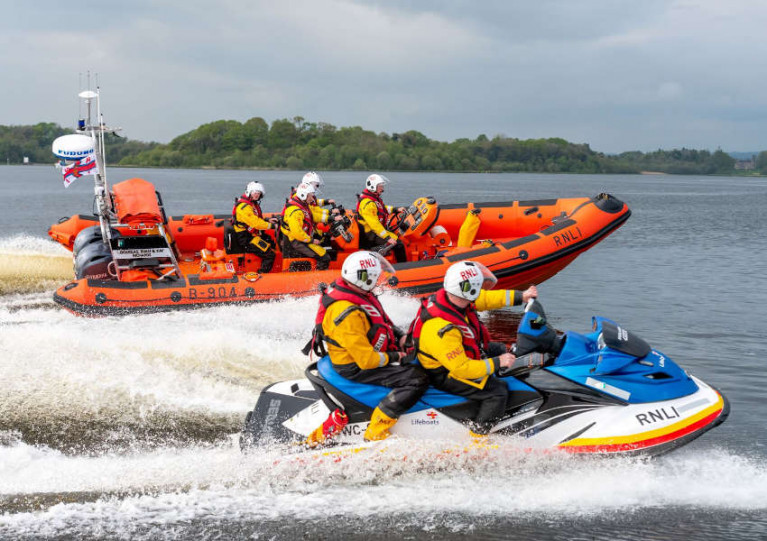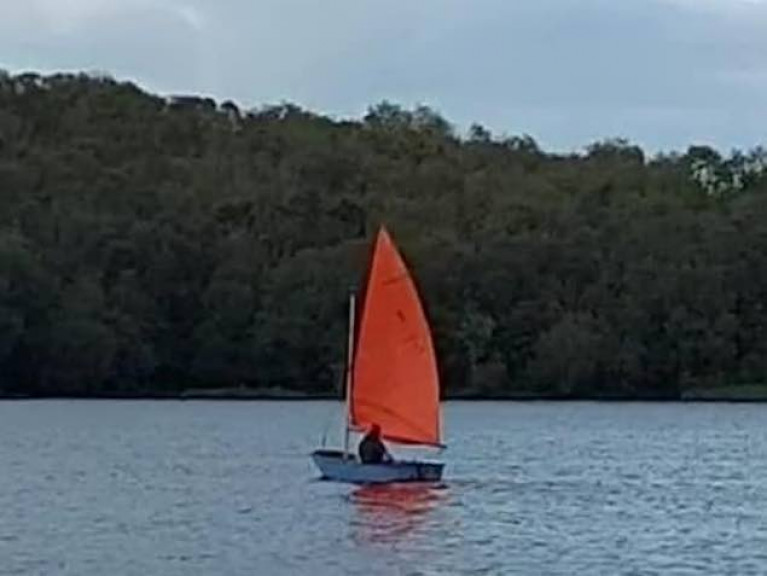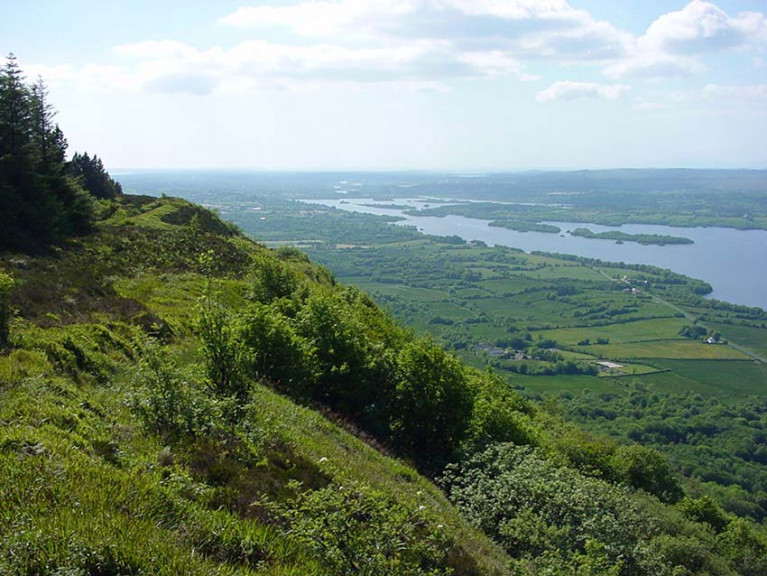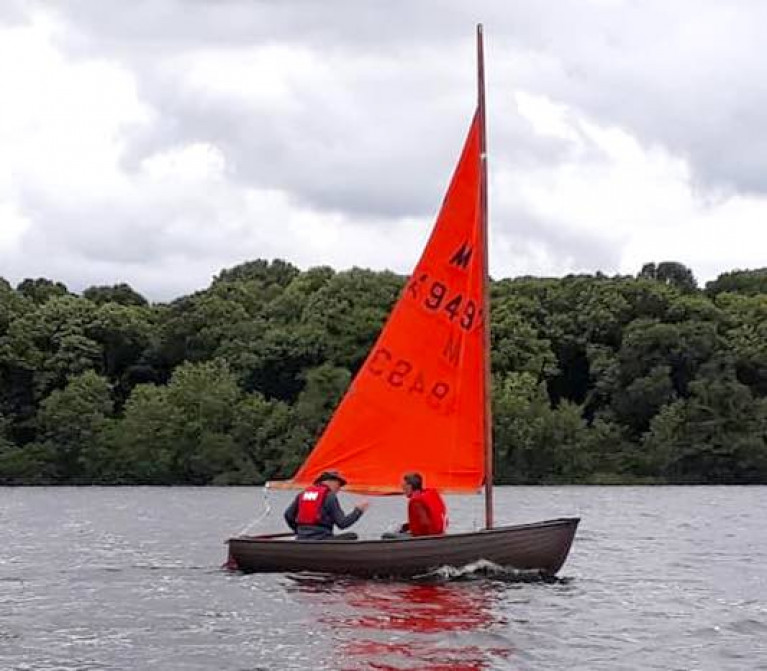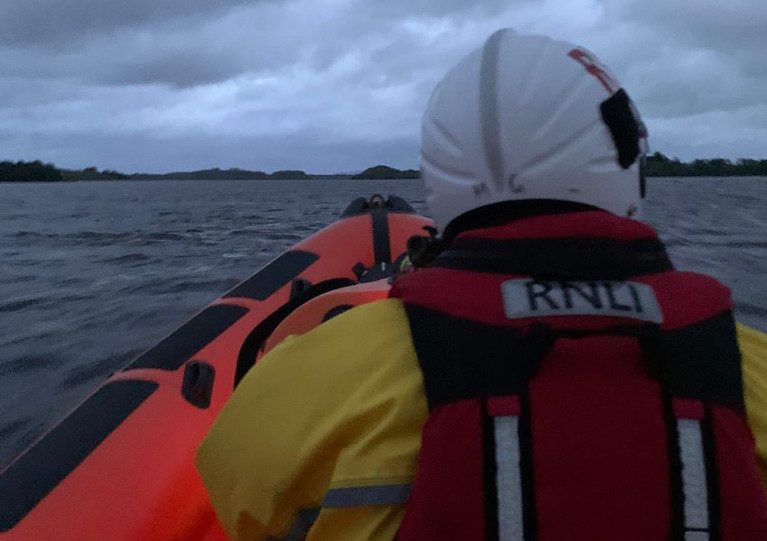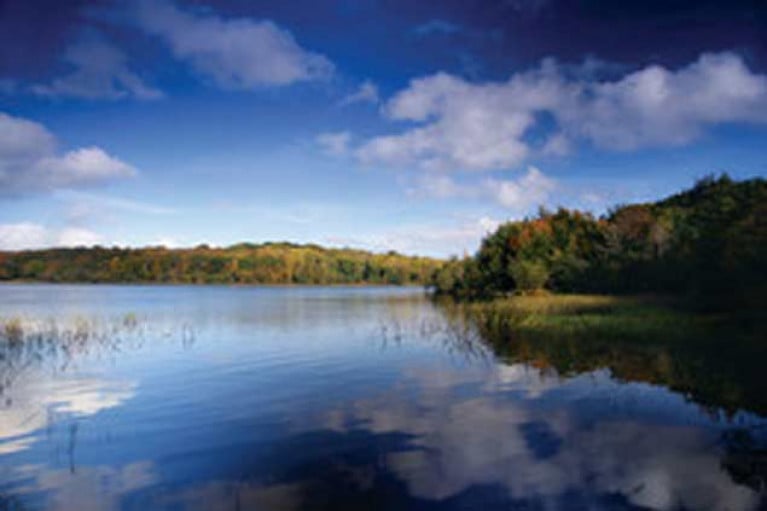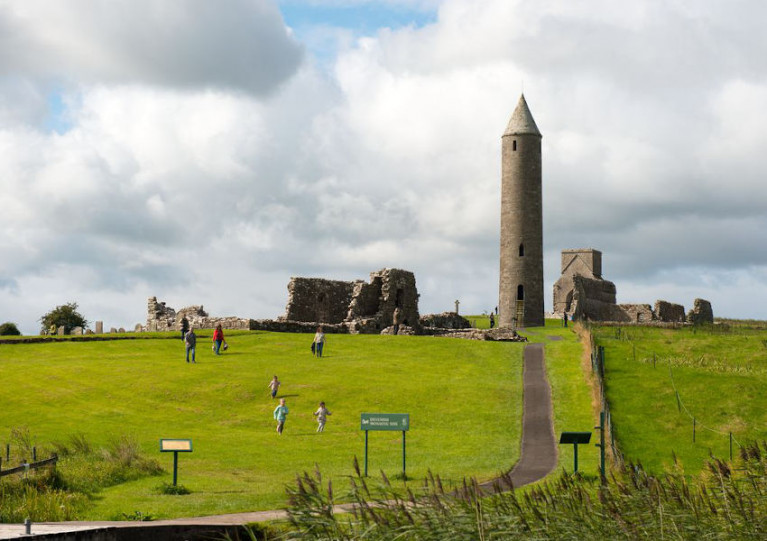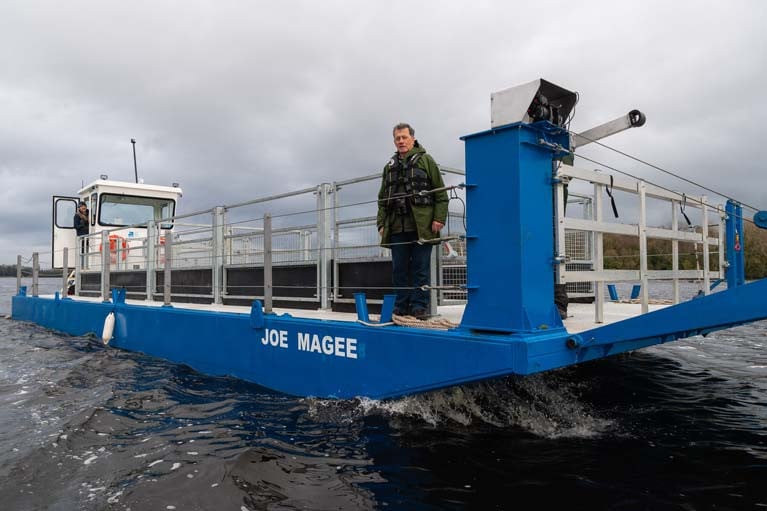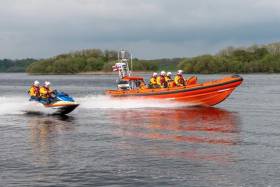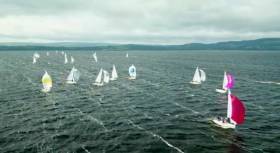Displaying items by tag: Lough Erne
Carrybridge RNLI Lifeboat Volunteers Launch New Online Fundraising Page
As the RNLI continues to operate as normal during the Covid-19 pandemic, the charity is still unable to fundraise out in person in the community.
With more people needing the lifeboat crews as they stay home, support from the public is more important than ever — and Carrybridge RNLI in Northern Ireland is one unit that has risen to the challenge by making it easier for people to back their vital work.
The RNLI operates two lifeboat stations for Upper and Lower Lough Erne, at Carrybridge and Enniskillen respectively, and has seen a drop in funds raised locally in 2020 as traditional fundraising activities had to be cancelled.
In many cases, when the lifeboat pager goes off, volunteers will need to abandon homeschooling or work and head to the lifeboat station to answer the call for help.
Stephen Scott, lifeboat operations manager at Carrybridge RNLI, says: “We couldn’t do what we do without the support of the public. The RNLI has experienced a drop in funds locally, but we are rescuing more people than ever before.
“We are facing challenging times and are calling on people to consider making a donation this year to ensure we can continue saving lives on inland waters.
“We have moved our fundraising online in these challenging times and set up a JustGiving page for the lifeboat station where people can donate directly to their local lifeboat station in Carrybridge.”
To support the RNLI at Carrybridge, helping to ensure the charity’s brave volunteers can continue saving lives on Lough Erne, visit their JustGiving page HERE.
1973 Mirror Dinghy Resurrected for Lough Erne
Brian Osborne last sailed a dinghy in 1989 on the River Thames near Hampton Court so returning to a small boat this season on Lough Erne was something of a revisit for him.
Brian bought a classic 1973 Mirror dinghy recently in Donaghadee, only to find that its original home had been on Lower Lough Erne at Castle Archdale on the opposite shore to Tully Bay where he keeps the Mirror now.
Perhaps this is the start of a trend in County Fermanagh for giving old boats a second chance as Jonny Clements has done with his Ulster Boat as Afloat.ie reported on 8th September. With the encouragement of seasoned sailor Fred Ternan – who had also helped Jonny to get afloat, it took Brian little time to regain his confidence.
A light north-westerly breeze on Tully Bay offered an ideal opportunity to try out (initially without the jib), manoeuvres which Brian thought he had forgotten but as he says "Once you learn how to sail, you never lose the feeling of being at one with your boat - you have to feel the wind through the sail and act accordingly. I shall continue to sail at every opportunity".
The Mirror dinghy was born in 1963 when the Daily Mirror newspaper signed up TV DIY expert Barry Bucknell and designer Jack Holt to revolutionise small boat ownership. They came up with a craft that cost £63 11s – or £63.55 in decimal money – and could be built at home using copper wire stitching and glue. At just under 10ft she was big enough for two adults and a couple of kids to sail yet small enough to fit on top of a family car.
Double Olympic silver medallist and round-the-world yachtsman Ian Walker, 42, said he owed his career to the boat.
The Mirror is not new to Lough Erne. There was a fleet in the 1980s at Lough Erne YC on the eastern shore of Lower Lough Erne at Goblusk. Racing was enjoyed by both adults and children alike in superb family competition. Some members ventured farther afield. Michael Clarke's family Mirror, built in 1966, travelled round Ireland on the top of a VW camper van in 1976 as well as enjoying extensive cruising on Lough Erne and subsequently under new ownership, was cruised by a young family on the Upper Bann and Lough Neagh.
Asked if he would be competing in the Mirror Worlds which are planned, after a gap of 34 years, for Sligo Yacht Club at Rosses Point next year he said. "I'll be there but as a supporter. I really don't have any intention of racing, just enjoying pottering about the Lough". The event on the Club's 200th Anniversary will run from 2 – 8 August preceded on 30 July – 1 August by the Irish Nationals. It was last held there in 1987.
Advisory Over Expected Reduced Water Levels On Lower Lough Erne
Users of the Erne System have been advised to expect reduced water levels throughout the navigation from Thursday 1 October.
This is when water levels on Lower Lough Erne are expected to be drawn down by DfI Waters to a minimum of 149 feet (above Poolbeg Ordnance Datum) ahead of anticipated rain throughout the rest of autumn and into winter.
Waterways Ireland advises that if water levels do fall on these inland waterways, masters should be aware of the following:
- Navigation: To reduce the risk of grounding, masters should navigate on or near the centreline of the channel, avoid short cutting in dog-legged channels and navigating too close to navigation markers.
- Mooring of vessels: Masters should be aware that water levels may change rapidly and that mooring lines will require adjustment. Therefore mooring lines should be checked regularly.
New Lease of Life for Small Clinker-Built Dinghy on Lough Erne
Last year Jonny Clements took part in a boating event in Lough Erne in a mixed fleet of craft from canoes to sailing boats. Having been impressed by the sailing dinghies and not having ever sailed before, he bought a 12-foot clinker-built wooden dinghy. Jonny was told that it had been built in Enniskillen and given its description and the photographs, thought it might be an Ulster Boat built by Tommy Sheridan of Enniskillen.
Tommy Sheridan and his brothers had a highly successful joinery business. And they did indeed produce the Ulster Boat which could be rowed as well as sailed. It was exhibited at the London Boat Show in Earls Court in 1965. But like all builders of wooden boats, production tailed off with the introduction of GRP.
Jonny had little work to do on the boat bar some minor repairs and varnishing and Fred Ternan of Lough Erne Heritage helped by fitting shrouds and the forestay from another dinghy, swaging new ends and thimbles and tensioning with lanyards. The dinghy is craftsman built and it and the original mast which has its original halyards had been well restored by Jonny.
With a Mirror mainsail supplied by Brian Osborne, the Lough Erne Heritage Facebook administrator, the dinghy was ready for the water. Despite the Mirror sail being a little too small, she was launched at Rossclare Jetty in Enniskillen in a pleasant North Easterly. The jetty is known locally as the Mooring Yard and is where the civilian company operating in support of the RAF in WW2 had their base.
With Fred's wise advice, Jonny and his father Ken, had their first hands-on experience of helming a dinghy, something they both found very interesting and enjoyable. Fred said "The boat sails very well even with the small mainsail I sent some books on the subject home with them. Just great to see a small clinker-built dinghy which someone had applied much skill to when building restored and saved for the future".
Jonny is delighted with his dinghy – "We thoroughly enjoyed our first experience of sailing and doing so in a vintage clinker-built dinghy was the icing on the cake. We look forward to exploring our sailing heritage and Lough Erne."
Six Rescued From Lough Erne Boats Jostled In Strong Winds As Fermanagh Braves Worst Of Storm Ellen
Six people were rescued from their boats on Lough Erne as Storm Ellen swept over Northern Ireland in the early hours of Thursday (20 August).
Enniskillen RNLI said the vessels, which were moored at the Devenish West jetty, were breaking their moorings in the strong winds.
All six passengers across the two brought to safety in Enniskillen aboard the inshore lifeboat.
Meanwhile, three other vessels breaking their moorings at Lough Erne Yacht Club were assisted by the lifeboat station’s shore crew.
Fermanagh braved the worst of Storm Ellen in Northern Ireland, while the Foyle Bridge in Derry had to be closed for a time amid gales and driving rain, as the News Letter reports.
Welcome Return for Boat Owners to Lough Erne
The Lough Erne branch of the Inland Waterways Association of Ireland (IWAI) welcomes the return to Lough Erne where boat owners with craft on the waterways can enjoy once more the beautiful scenery of this part of County Fermanagh, with the proviso that they adhere to the Executive’s advice about social distancing and practice good hand hygiene.
The suggested recommendations by the IWAI are:-
1. Please ensure that you are travelling directly to and from your boat, not stopping for supplies on your journey. You should prepare in advance and consider what provisions you will need when you are doing your weekly food shopping.
2. Be aware of the following surfaces and avoid contact if possible:
- Locked Gates, Keypads or access restrictions
- Water taps and shore power bollards
- Handrails, benches, light switches, boat or jetty cleats, and other frequent touchpoints
- Shared use trollies or wheelbarrows, fuel drums or pumps
- Where you do make contact with the above surfaces, ensure you do not touch your eyes, mouth, nose, or face until you have thoroughly washed or sanitised your hands.
3. Water taps should not be used at this time – please bring a supply of safe drinking water with you to your boat.
4. Please be aware that trolleys may not be available - consider how you will carry your belongings to/from your boat, limiting close contact with others through repeated trips.
5. While visiting your boat and within marinas, practice and maintain social distancing at all times. Please be patient and courteous to other marina and lough users. Take your time and allow sufficient 2-metre physical distance to pass on jetties. Use finger jetties or stay aboard your boat until it is safe to pass.
6. Please remain on your own boat and do not board others’ boats to socialise regardless of how tempting this may be.
7. Should you choose to cruise at this time, please be mindful that your actions have consequences. Owners should ensure their boats are well maintained and fully de-winterised following a protracted period of not being used; and that weather conditions, health conditions, and level of boating experience can all influence the likelihood of requiring assistance from emergency responders. Owners should also check which marinas and facilities around the Lough are open. Plan and prepare to spend time afloat completely self-sufficiently. This may include electric and water supplies on public jetties. It is also recommended that you do not pass through stretches where it is necessary to operate lock gates in order to minimise the risk of cross-contamination.
It should be noted that currently, all toilets and other marina facilities will be closed in compliance with Government guidance and that even simple helpful tasks like throwing/receiving a rope from a mooring vessel increases your risk of contracting or spreading the virus and should be avoided where possible.
Finally, the Lough Erne branch of IWAI says “ while we have all worked hard and made sacrifices to reach a point where it is considered safe to return to the lough, please do not become complacent. The threat of contracting Covid-19 is still very real, and we all have a responsibility to limit it’s spread”.
Lough Erne Locals Called To Share Folklore, Histories & Stories For Spiritual Trail Project
Shared stories of folklore and the history of spiritual sites around Lough Erne will be the subject of a public meeting at Waterways Ireland HQ in Enniskillen later this month.
Hosted by Waterways Ireland in partnership with the Lough Erne Landscape Partnership, the community outreach event encourages locals around the Fermanagh waterway to drop in and share their stories and folk tales, as well as memorabilia and photographs, that only they would have.
Doors will be open from 1pm to 8pm on Monday 27 January, with the Centre for Data Digitisation and Analysis at Queen’s University Belfast on hand to record these oral histories and more for posterity.
The project will also inform the development of the Lough Erne Spiritual Trail, an initiative of Waterways Ireland and the Lough Erne Landscape Partnership.
Eleven significant spiritual and/or ecclesiastical sites have been selected, including Devenish Island, White Island (North), Davy’s Island, Inishmacsaint, Caldragh (Boa Island), Cleenish, St. Ronan’s Aghalurcher, Galloon, Killadeas, Derryvullen and Tievealough.
The traditional Lough Erne Cot is a vessel unique to Upper and Lower Lough Erne and used there for possibly 2000 years. It was popular for transporting goods, people and cattle around the islands in the lakes in County Fermanagh and some versions are still used today for carrying cattle.
The cot was uniquely suitable for this purpose, being flat bottomed, wide in the middle and narrow in its turned-up ends. Some were surprisingly long at 15 to 18 metres. But the latest design of the ‘cot’ commissioned by the RSPB, is a far cry from the original. It’s a 15m custom-made 14-ton vessel built by Welsh marine engineers and workboat builders Mainstay Marine Solutions.
As Afloat previously reported, not only will it transport livestock but also machinery, equipment and people and its deck space can be altered depending on the cargo. It can also be dismantled into sections for ease of road transportation.
The grazing of cattle on the islands helps ground-nesting birds by providing cover. The livestock creates a suitable structure of grass and vegetation to form an ideal habitat for breeding wading birds including curlews, lapwings, redshanks and snipe to nest and raise young.
The boat has been named the ‘Joe Magee’ after a former RSPB Fermanagh warden who had noticed the alarming decline in wading birds during his time there. The new cot was acquired through the Co-operation Across Borders for Biodiversity (CABB) project, which receives financial support from the EU’s INTERREG VA Programme, managed by the Special EU Programmes Body (SEUPB). CABB is improving the habitat for breeding wading birds at several sites in Northern Ireland and the Republic of Ireland and blanket bog habitat in NI, Scotland and the Republic of Ireland.
RSPB NI has operated a cot to transport livestock between islands on Lower Lough Erne since 1991. The original was designed by Joe Magee but needed to be replaced due to wear and tear.
RSPB NI area manager Brad Robson explained: “The cot is used throughout the year. We move about 150 cattle and 60 sheep back and forth to our managed islands, as well as livestock to other privately owned islands. In its first voyages, the new vessel will be used to bring livestock off for the winter”.
Joe Magee added: “We originally used a wooden cot, which a farmer let us use, and then we built our own. “Although at first it had no engine on it, and we had to tow it using another boat. So eventually we got an engine and that made life easier. “I knew that across the island of
Ireland curlew numbers were dropping, so it’s important that work is still being done to look after them.”
Mr Robson said the RSPB's work is essential and by using cattle to manage the grassland they can give curlews "the best possible opportunity that they can rear young successfully”.
Underlining the importance of this part of the project, Gina McIntyre - CEO of the SEUPB - said: “The curlew is one of a number of endangered priority species identified in the environmental protection measures within the EU INTERREG Programme. This new cot is a fantastic example of the tangible impact that EU INTERREG funding is having in safeguarding the natural environment and protecting endangered species, on a cross-border basis. Due to this intervention by the CABB project, curlews will have a much better future. I also want to commend Joe for his commitment to conservation.”
You can read more here
Carrybridge RNLI Seeks New Lifeboat Volunteers For Lough Erne
Carrybridge RNLI is looking for new volunteer crew members to join its search and rescue service on Lough Erne.
The station, on the River Erne between the upper and lower loughs, is now calling on potential recruits to come forward and learn how they can get involved in helping the charity continue to save lives at sea and on inland waterways.
Later this month, on Thursday 21 November from 7pm, the lifeboat station will be hosting an open evening for all interested candidates to learn more.
Originally part of Enniskillen RNLI, Carrybridge RNLI was established in 2002 due to the increase in pleasure boating activity on Lough Erne.
In October 2015, a new station was officially opened and a larger Atlantic 85 lifeboat was placed on service in November 2017, to replace the older Atlantic 75 and to join the existing rescue water craft (RWC).
To date the lifeboat, Douglas Euan and Kay Richards, and RWC have launched 41 times on service in addition to weekly training exercises.
Stephen Scott, Carrybridge RNLI lifeboat operations manager, is now calling on any potential volunteers to come along to the open evening and find out more.
“We are looking for anyone aged 17 years and over who is willing to offer some of their free time to join what I believe to be one of the most exhilarating and rewarding voluntary services that is out there,” he said.
“While experience on the water is helpful, every volunteer receives first-class training from the RNLI and learns new skills which can benefit them in many walks of life. Lifeboat crew members need to have a reasonable level of fitness.”
Anyone who feels they have the time and commitment to volunteer for the charity which is on call 24 hours a day, 365 days a year, is asked to email Stephen at [email protected]
While the official entry was thirty-one for the 2019 J24 Irish National Championships at Lough Erne Yacht Club, twenty-eight made it to the first start line including five under 25 teams writes Elaine O'Mahoney.
The under 25 team from Royal Cork Yacht Club at their first J24 event were unfortunate to have broken a mast immediately after the start of the first race but thanks to the efforts of Lough Erne Yacht Club they are being loaned another boat to enable them to compete in day two. The 2019 AGM took place after racing and Brian McDowell from Howth Yacht Club stepped down as President.
The committee would like to thank Brian and also Martin O’Reilly and Sinéad Enright who are also stepping down this year, for all their hard work and commitment to the association over the past few years. We would also like to wish newly elected President Mark Usher from Greystones Sailing Club the very best of luck and to welcome Tadgh O’Loinsigh from Tralee Bay Sailing Club as the Under 25 representative on the new committee.
We asked three boats to give a summary of their first day of racing at the J/24 National Championships in Lough Erne Yacht Club.
Reports from the Fleet
The forecast said “ten knots, gusting close to twenty”, but as the fleet made its way to the race course it was clear that the “Breeze was on” for Day 1.
The starts were hectic with twenty-eight boats fighting for front row positions, the fleet got away clean for three of the four races.
The upwind legs were a battle between finding flatter water and picking your way through the wind shifts across the broad Lough. There were gains to be made on both sides of race course and all through the fleet boats traded positions with only small margin making the difference of often multiple places.
The front half of the fleet was always still tightly packed as they approached the first windward mark, and with spinnakers hoisted and powerful gusts, the downwind legs in the first couple of races were fun and felt short.
The leeward gate created opportunities as the fleet split each time for a second lap.
By the time the warning signal for Race 3 was raised, the breeze showed signs of dropping a little and about half the fleet made the change to their larger head sail. On balance, those who stuck with Jib’s probably fared better during the next race and only by Race 4 had the wind moderated enough to make sailing with the J24’s big Genoa really manageable.
With testing wind conditions and a very competitive fleet every place was fought for and as is so often the case in big fleets consistency was the key to success on day 1. After four races completed and still no discard, the McCormacks Stouche from Foynes Yacht Club managed to stay just ahead of Flor O'Driscoll's team in Hard on Port. Behind them and still in the running to grab the National title are the local team of JP Caldin on Il Ricco and Headcase owned and sailed by the first graduates of the Howth YC J24 “Under 25” development programme.
Day 2 promises a little less wind but even more competition. - Brian Raftery - Gossip
Windier conditions today than expected gusting 25/26 kts easily. Some excellent close racing, testing the crew's boat handling and tactical skills. A great job from the race committee getting all four scheduled races in. Roll on day two. - Team Jumpin’ Jive
So glad to be out here in Enniskillen what a fantastic venue to compete in. Our teams first time racing here and it didn’t disappoint. While our results weren’t as good as we would have originally hoped we had a great day on the water all the same. OOD Derek Bothwell and his team set great courses which made for extremely competitive and nail-biting races for us all day long. We were met with testing conditions at the beginning of the day which gradually eased. It took us a while to get the boat going but we dusted off the cobwebs and eventually got into the groove. We are happy to say our results improved as the day progressed. Hopefully, our performance will continue to improve tomorrow and the day after. - Foynes Yacht Club Under 25 Team


























